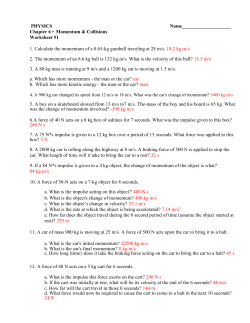
MOMENTUM AND COLLISIONS
LINEAR MOMENTUM Momentum = Mass x Velocity p=mv The SI unit for momentum is kg·m/s Momentum and velocity are in the same direction Is a vector Using the equation p=mv At the same velocity, as mass increases – momentum increases At the same mass, as velocity increases – momentum increases 3 Example You are driving north, a deer with mass of 146 kg is running head-on toward you with a speed of 17 m/s. Find the momentum of the deer. p=mv p=146 kg * 17 m/s p= 2500 kg·m/s to the south CHANGING MOMENTUM A change in momentum takes time and force For example soccer – when receiving a pass it takes force to stop the ball It will take more force to stop a fast moving ball than to stop a slow moving ball A toy truck and a real truck moving at the same velocity, it will take more force to stop the real truck than to stop the toy truck IMPULSE Impulse is the applied force times the time interval FΔt Impulse = FΔt Force is reduced when the time interval increases Example – giving a little when you catch a ball Trampoline IMPULSE-MOMENTUM THEOREM From Newton’s second law And the equation for acceleration: a=v/t We can find the equation for force in terms of momentum F=Δp/Δt Force = change in momentum / time interval We can also rearrange this equation to find the change in momentum in terms of external net force and time Δp=FΔt, Δp=FΔt=mvf-mvi (it will never go away) Example A 0.50 kg football is thrown with a velocity of 15 m/s to the right. A stationary receiver catches the ball and brings it to rest in 0.020 s. What is the force exerted on the ball by the receiver? p=mv Δp=FΔt=mvf-mvi vi= 15 m/s vf=0.0 m/s t=0.020 s F*0.020 s = 0 – 0.50 kg*15 m/s F= 380 N IMPULSE-MOMENTUM THEOREM AND STOPPING DISTANCE The impulse-momentum theorem can be used to determine the stopping distance of a car or any moving object Use Δp=FΔt So Δt=Δp/F=mvf-mvi/F Then when you find time you can use distance = average velocity * time Δx=1/2(vf+vi) Δt Example A 2240 kg car traveling to the west slows down uniformly to rest from 20.0 m/s. The decelerating force on the car is 8410 N to the east. How far would the car move before stopping? Δt=Δp/F=mvf-mvi/F Δt=0-2240kg*20.0m/s / 8410 N Δt = 5.33 s Δx=1/2(vf+vi) Δt Δx=1/2(0+20.0m/s)*5.33 x=53.3 m to the west What happens to momentum when two or more objects interact? First you have to consider total momentum of all objects involved. This is the sum of all momentums Like energy momentum is conserved Conservation of Momentum: Total initial momentum = total final momentum m1v1i + m2v2i = m1v1f + m2v2f Example A boy on a 2.0 kg skateboard initially at rest tosses an 8.0 kg jug of water in the forward direction. If the jug has a speed of 3.0 m/s relative to the ground and the boy and the skateboard move in the opposite direction at 0.60 m/s, find the mass of the boy. m1v1i + m2v2i = m1v1f + m2v2f m1=mass of jug = 8.0 kg m2= mass of boy and skateboard= 2.0 kg + x V1i = 0, v2i = 0 V1f = 3.0 m/s, v2f=0.60 m/s 0=8.0kg*3.0m/s forward + (2.0kg +x)*.60m/s back 24 kg·m/s = (2.0 kg + x)*.60 m/s 40 kg = 2.0 kg + x x= 38 kg Newton’s Third law and Collisions If the forces exerted in a collision are equal and opposite And the time each force is exerted would be the same Than the impulse on each object in a collision would be equal and opposite Since impulse is equal to the change in momentum than the change in momentum would be equal and opposite So if one object gained momentum after a collision than the other object must lose the same amount of momentum Collisions When two objects collide and then move together as one mass, the collision is called a Perfectly inelastic collision These are easy situations because the two objects become pretty much one object after the collision So the conservation of momentum equation becomes m1v1i + m2v2i = (m1 + m2)vf The two objects will have the same final velocity Example A grocery shopper tosses a 9.0 kg bag of rice into a stationary 18.0 kg grocery cart. The bag hits the cart with a horizontal speed of 5.5 m/s toward the front of the cart. What is the final speed of the cart and the bag? m1v1i + m2v2i = (m1 + m2)vf 0 + 9.0kg * 5.5 m/s = (18kg + 9kg)vf 50. kg m/s = 27*vf 1.9 m/s Kinetic Energy and Inelastic Collisions Total kinetic energy is not conserved in inelastic collisions, it does not remain constant Some of the energy is converted into sound energy and internal energy as the objects deforms during the collision This is why it is called inelastic, elastic usually means something that can keep its shape or return to its original shape In physics elastic means that the work done to deform an object is equal to the work done to return to its original shape In inelastic collisions some of the work done on the inelastic material is converted to other forms of energy such as heat or sound Example A 0.25 kg arrow with a velocity of 12 m/s to the west strikes and pierces the center of a 6.8 kg target. What is the final velocity of the combined mass? What is the decrease in kinetic energy during the collision? m1v1i + m2v2i = (m1 + m2)vf 0 + 0.25 kg *12 m/s = (0.25 kg+ 6.8 kg)v vf=0.43 m/s to the west KEi = 0+ ½ 0.25*(12m/s)2 = 18 J KEf = ½ (7.1 kg)*(0.43 m/s)2 = .66 J Change in kinetic = 17 J Elastic Collisions In an elastic collision, two objects collide and return to their original shapes with no loss of total kinetic energy. The two objects move separately Both total momentum and total kinetic energy are conserved Since both are conserved than these equations apply m1v1i + m2v2i =m1v1f +m2v2f ½ m1v1i2 + ½ m2v2i2 = ½ m1v1f2 + ½ m2v2f2 Example A 16.0 kg canoe moving to the left at 12.5 m/s makes an elastic head-on collision with a 14.0 kg raft moving to the right at 16.0 m/s. After the collision, the raft moves to the left at 14.4 m/s. Disregard any effects of the water. Find the velocity of the canoe after the collision. Verify your answer by calculating the total kinetic energy before and after the collision. Collisions in Two or more Dimensions Conservation of momentum still applies Use your vectors. Momentum is conserved in all directions pxi=pxf pyi=pyf mAvAxi +mBvBxi = mAvAxf +mBvBxf mAvAyi +mBvByi = mAvAyf +mBvByf Center of Mass (CM) The point at which all mass of an object can be considered to be located An object can be considered a point or small particle no matter what the size or shape of the object Center of mass moves just as a particle moves no matter what the object does Finding the center of mass of an object Define a coordinate system (preferably one that would make the math easy) Center of mass can be found by finding the sum of all the masses times their respective distance from the defined origin and dividing by the sum of all the masses m A x A mB x B x cm m A mB Center of gravity (CG) The point at which the force of gravity can be considered to act Gravity acts on all parts of the object But for determining translational motion we can assume that gravity acts in one particular spot Same spot as the center of mass
© Copyright 2025
















